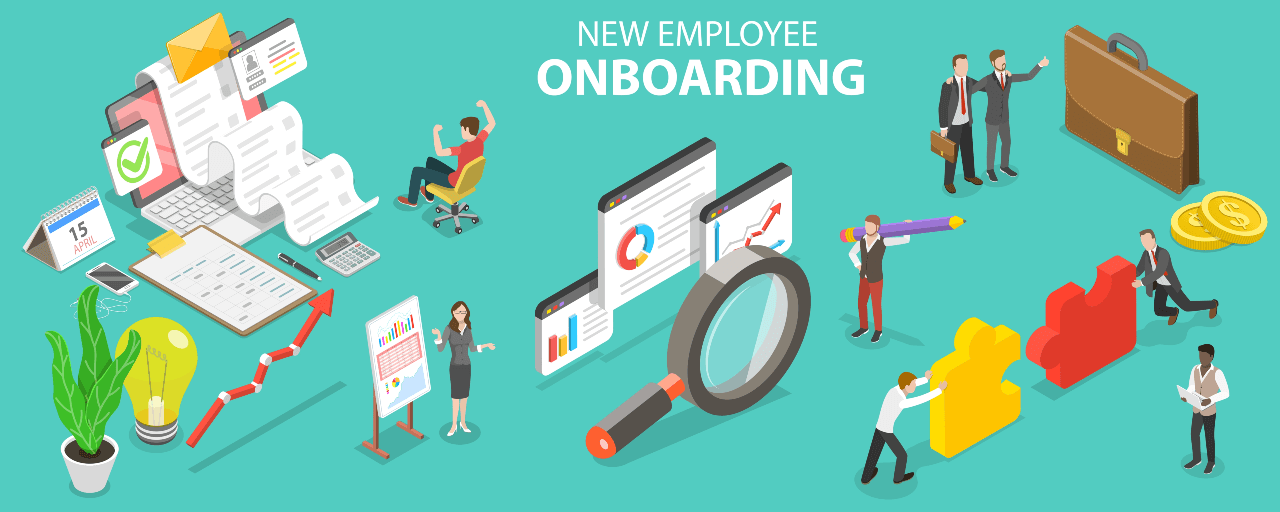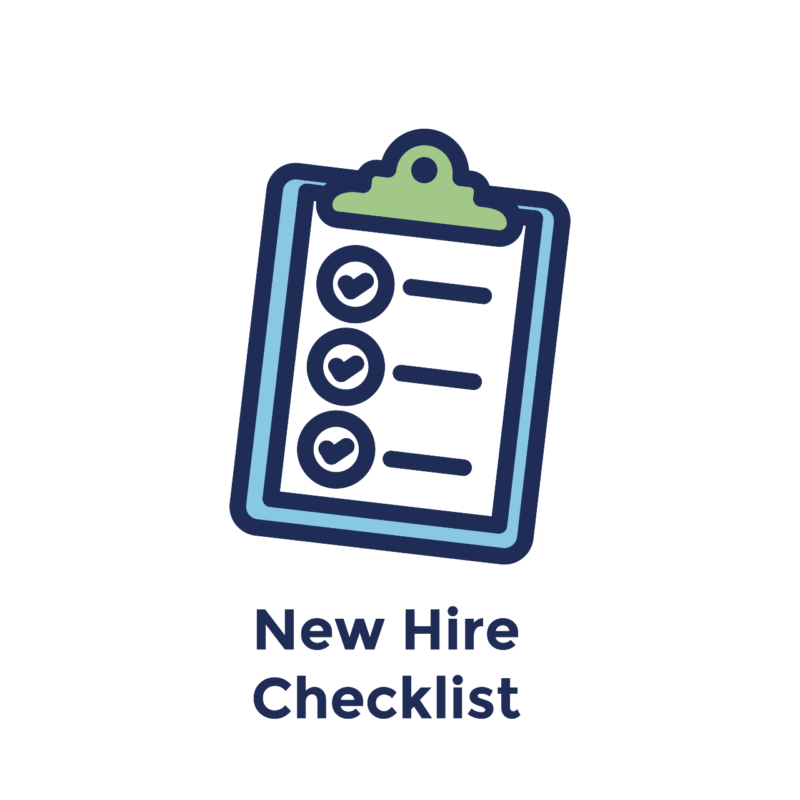A step-by-step guide & checklist for new employee onboarding in 2023
A new employee onboarding checklist is a must-have for companies and organizations. Read on and create a perfect onboarding experience.

Onboarding 101
Employees are expected to show up prepared on their first day of a new job, so why shouldn’t businesses come prepared for the onboarding process? New employee onboarding when done incorrectly can leave all parties feeling overwhelmed and confused.
Instead of treating new employee onboarding as an improv experience, we suggest creating a checklist that will guide you through and ensure that nothing important is left out. A step-by-step onboarding guide will also make it clear to the new employee exactly what their position entails and what that looks like in practice.
So if you were on the fence about whether or not to create a checklist for new employee onboarding, the answer seems to be clear. The rest of the article will explain everything you need to know to get your onboarding checklist in order before your next employee is hired.
What is employee onboarding?
Employee onboarding is the process of a new employee joining the company. Employee onboarding will probably look slightly different in every company, but the overall goal remains the same, to familiarize the new employee with the way things work in the company, and what their responsibilities will be.
New employee onboarding should leave the new hire feeling prepared to do their job and provide them with the tools to do so. The onboarding process does not have a set time limit, but you don’t want to rush through things too quickly. It takes time to build relationships and that is also true when it comes to a new employee building a relationship with a company.
A proper onboarding process is critical
After putting in the time and effort it takes to interview and hire a new employee, the last thing you want is to lose them because of a messy onboarding process. In fact, 93% of employers believe that the onboarding process plays a critical role in whether or not an employee will choose to stay with a company.
Forbes reports that 31% of employees are most likely to leave within their first six months at a new company, making this time critical for employee retention. The more an employee feels they are equipped to be productive in their new position, the more likely they are to stay. No one wants to feel clueless or useless, period.

Setting expectations and introducing objectives
The truth is that the onboarding process begins before the new employee’s first day in the office. So when does onboarding begin, you might ask?
1 – The offer stage
From the moment your company sends an official job offer to a recruit, the onboarding process has begun. It is crucial that from the beginning you approach the hiring process with as much clarity as possible so that your new employee feels sure of what is expected of them. This will also be your opportunity to clearly introduce employee and company objectives.
For this reason, it is a good idea not only to build your new employee onboarding checklist from the employee’s first day but from the time an offer is released onward.
2 – Keep it clear!
At the offer stage, you want to ensure that the employee has received a clear job description, and information on company policies, benefits, and salary offers. At this stage, it might be a good idea to conduct any negotiations via telephone so that the new recruit will start to get to know the HR department on a more personal level.
3 – The acceptance stage
Once negotiations have been reached and the offer has officially been accepted, the next stage of onboarding will include more formal steps like signing a contract and presenting the new employee with any additional information they should have before their first day. Companies often present new employees with a handbook outlining things like vacation policy, safety information, workplace conduct information, and confidentiality agreements, if relevant.
4 – The waiting period
Keep in mind that if there is a waiting period between the new employee accepting the offer and their actual start date in the company, you will want to use this opportunity to build a relationship with them. Don’t just sign the contract and then leave them hanging. You want your new employee to feel excited leading up to their new job.
You will also want to use “pre-boarding” as an opportunity to inform the rest of the company that a new employee will be joining the team. This way when new employees arrive they will feel more welcomed by their new colleagues.
Onboarding checklist & process flow for new employees

The first day on the job can be exciting and a little nerve-wracking for anyone. Even if you have prepared them to the best of your ability before the big day. This is why it is so important to have a clear onboarding plan in place so that everything flows smoothly on the first day in the new office.
While there is room for variation, the following seven steps should definitely be included on any new onboarding checklist.
1. Introductions
On the day of, you want to do everything you can to make the new employee feel comfortable and accepted. Make sure that their workstation is prepped and ready for their arrival and including a little welcome basket or a small gift is always a nice gesture.
When the employee arrives, either a member of HR or a mentor should greet them. Hopefully, at this stage, the new employee will have already met this person either during the interview process or over the phone. This person should play a major role in guiding the new employee throughout their first day.
2. Schedule meetings with various heads of departments
Meetings should be scheduled throughout the first day with various heads of departments for a quick intro to the new employee. This list can include the employee’s direct boss, the head of HR, and the head of the company, if relevant. By meeting people face to face the new hire will begin to understand different people’s responsibilities in relation to their own and who they can turn to for any specific needs or questions.
This is also a great opportunity to introduce the new employee to their colleagues. This can be done on more of an individual basis or if the team is relatively small, all at once.
3. Orientation
Once introductions have been made, it is time to take care of any technical aspects of new employee onboarding. This is the time to give the employee a tour of the facilities if you haven’t already done so. Let them know where they can eat lunch and when, where people take breaks, and how to reserve a room for meetings.
This is also the time to sign any remaining paperwork that operations might need. This might include bank information for their salaries, personal information for tax purposes, and also explaining how to officially request time off or what to do if they are sick.
4. IT – set up for new employees
Orientation will also include getting set up with IT. IT will get the new employee set up with a computer and make sure they have information like their email address and password, along with anything else they need to do their jobs.
5. Role-specific training
Next up on the new employee onboarding checklist is role-specific training. While this step should be started on the first day, it should continue over the first few weeks and even months that the employee is in the office. Remember, you don’t want to overload them with information and it will take time to get things down.
This step should give the employee a clear idea of what their day-to-day responsibilities will include, and how to complete them. If there are any internal systems or programs they will need to do their job, this is the time to introduce them. This will also include any specific training about how to use these tools if they don’t already have experience with them.
6. Explain the roles of different team members
You will want to take this opportunity to explain the roles of different team members and how they will interact with the new employee. Basically, you want to ensure that the employee understands the overall objectives of the company and how they fit into them.
7. One-on-one with the direct manager
While the new hire should have been introduced to their direct manager briefly at the beginning of their day, an important part of new employee onboarding will include continuous one-on-one meetings throughout the entire onboarding process.
The purpose of these meetings, in the beginning, will be to make expectations clear and begin to build a relationship between the employee and their manager. As this relationship grows, the meetings will serve as an opportunity to consistently check in with one another. The manager will be able to give the employee feedback about their progress, while the employee will be able to voice any concerns or ask any questions.
Building strong relationships is an important part of employee retention and especially during the onboarding process. The new employee should feel that their direct manager is someone they can count on, especially as they are still learning.
8. Plan a team activity
Another step on the new employee onboarding checklist is to make sure the new team member is successfully integrating with their colleagues. It can be difficult to break the ice during office hours when everyone is focused on getting work done. Instead, plan a team activity that will give the new employee a chance to get to know everyone a little better.
This team activity can be as simple as a group lunch in the office, but if you want to take it a step further and plan something outside the office feel free. Sometimes it can be difficult for people to open up in the workplace so even planning a lunch in a restaurant instead of the cafeteria might just do the trick.
9. Checking in
Remember, new employee onboarding goes well beyond the first few days in the office. Once the employee has started to get the hang of their position, the next step in the onboarding flow is to check in with them about their experience thus far in the company. Engaging with employees after they have been in the company for a few months is another important part of retention.
The “check-in” should be done with both the employee’s manager as well as HR. The end of a business quarter is a good time to make it happen. This is an opportunity to ask the employee about how their expectations have been met and if they have any feedback or concerns. This is also a great time to give the employee feedback and begin to set long and short-term goals for their future at the company.
10. Reboarding
Given that everything goes according to plan with the new employee onboarding process, the new employee will stay on in the company long enough that they will eventually grow into a more senior employee. Each time an employee gets a promotion or moves to a different role in the company, they will need to undergo a similar onboarding process AKA reboarding.
The reboarding process won’t be exactly the same as new employee onboarding, of course, but the principles of both remain the same: ensuring that an employee understands their role in the company and is equipped with the tools to make it happen.
Why centralized email signatures are an important part of the onboarding process
It can be extremely difficult for new employees to keep everyone in the company’s names, faces, and positions straight. It can also be extremely embarrassing to get it wrong. Imagine getting an email from the head of your department and having to ask what it is they do again.
Using centralized email signatures is a great way to avoid all of that. Email signatures are the perfect way to convey each person’s name, title, and contact information so that every new employee can be confident that they have all the information correct.
Click to create a company-wide email signature

To conclude
Companies put a ton of time and money into recruiting quality employees and the best way to protect their investment is by creating an organized new employee onboarding system. Retaining these employees is extremely dependent on how their first few months in the company go, which is when onboarding takes place. Take the time to prepare so that both you and your new hires feel comfortable throughout the onboarding process and long after.

